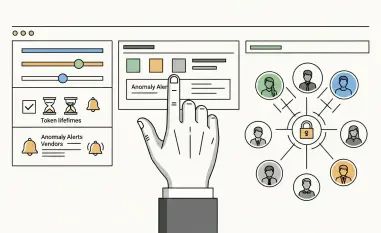Setting the Stage for a Digital Crisis
Imagine a world where a single click can lock away millions in cryptocurrency assets, with no hope of recovery unless a hefty ransom is paid. This isn’t science fiction but a stark reality in 2025, as AI-driven crypto ransomware emerges as a dominant force in cyber warfare, targeting the blockchain ecosystem with ruthless precision. The global market for cybersecurity is reeling under the weight of this unprecedented threat, with ransom payments already surpassing billions annually. This analysis dives into the intersection of AI and blockchain crime, exploring market trends, financial impacts, and future projections for an industry at a critical juncture. It aims to uncover how these sophisticated attacks are reshaping the cybersecurity landscape and what strategies can mitigate their devastating effects.
Unpacking Market Trends in AI-Driven Ransomware and Blockchain Vulnerabilities
The Surge of AI as a Cybercrime Catalyst
The cybersecurity market is witnessing a seismic shift as AI transforms ransomware into a highly adaptive and automated weapon. Unlike traditional malware, which relied on static patterns, AI-powered variants leverage machine learning to evolve in real-time, targeting blockchain assets like crypto wallets with alarming accuracy. Recent data indicates that 80% of ransomware incidents analyzed in the past two years utilized AI, highlighting its pervasive adoption among cybercriminals. This technological leap has driven a significant uptick in attack frequency, with market analysts noting a growing demand for advanced defensive tools to counter such sophistication. The rapid pace at which AI enhances malware capabilities is pushing cybersecurity vendors to innovate at breakneck speed, creating a volatile yet opportunity-rich market environment.
Blockchain as a Lucrative Target for Extortion
Delving deeper into specific sectors, blockchain technology stands out as a prime target due to its inherent characteristics, such as pseudonymity and the irreversibility of transactions. These features, while beneficial for privacy, provide a perfect cover for ransom payments in cryptocurrencies like Bitcoin or Monero, making tracing nearly impossible. The market for decentralized finance (DeFi) platforms and crypto exchanges has seen a sharp rise in attacks, with average ransom demands hitting $1.13 million in the second quarter of this year. This vulnerability has spurred a niche market for blockchain-specific security solutions, as companies scramble to protect digital assets. The trend signals a growing need for specialized tools that can address the unique risks posed by decentralized systems, opening avenues for startups and established firms alike.
Economic Ripples and Market Instability
The economic impact of AI-driven ransomware on blockchain ecosystems is reshaping market dynamics across multiple industries. Annual ransom payments have exceeded billion in recent years, with recovery costs per incident often reaching million, particularly affecting sectors like manufacturing and government. This financial strain is driving up cybersecurity budgets, with projections estimating a 40% increase in victim counts by 2027. The market for cyber insurance is also expanding rapidly as businesses seek to mitigate losses, though premiums are skyrocketing due to heightened risk. Such economic fallout is creating a dual effect: while it burdens companies with costs, it simultaneously fuels growth in security-related services, positioning cybersecurity as a critical investment area for the coming years.
Projections and Future Market Directions
The Escalating Cyber Arms Race
Looking ahead, the market is bracing for an intensified arms race between AI-powered attackers and defenders within the blockchain space. Forecasts suggest that ransomware will achieve greater autonomy by 2027, with self-evolving algorithms capable of bypassing even the latest defenses. On the defensive front, AI systems designed for real-time threat detection are expected to become mainstream, potentially commanding a significant share of cybersecurity spending. Market analysts predict that explainable AI, which clarifies automated decision-making, will be a key differentiator for vendors, fostering trust among enterprise clients. This ongoing battle is likely to redefine competitive landscapes, with tech giants and agile startups vying for dominance in a rapidly evolving sector.
Regulatory and Collaborative Market Shifts
Another critical projection centers on the role of regulation and collaboration in shaping market responses to AI-driven threats. There is growing momentum for global standards on AI security, which could standardize practices across borders and influence market entry barriers for cybersecurity firms. Industry collaboration is also anticipated to rise, with shared threat intelligence platforms becoming a cornerstone of defense strategies. Governments are expected to play a larger role, potentially subsidizing cybersecurity initiatives in vulnerable sectors, which could alter market dynamics by leveling the playing field for smaller players. These developments point to a future where policy and partnerships are as crucial as technological innovation in driving market stability.
Emerging Opportunities Amidst Challenges
Despite the grim outlook, the crisis is catalyzing unique market opportunities for innovation. The demand for AI-powered defensive tools is projected to grow exponentially, creating fertile ground for companies specializing in predictive analytics and behavioral threat detection. Blockchain security, in particular, is emerging as a high-growth niche, with potential for significant returns on investment for firms that can deliver robust solutions. Additionally, the integration of cybersecurity into broader tech ecosystems by major players like cloud service providers could redefine market structures, offering bundled services that address both traditional and blockchain-specific risks. This evolving landscape underscores the potential for strategic positioning to turn a pressing threat into a catalyst for market expansion.
Reflecting on Insights and Strategic Pathways Forward
Reflecting on the analysis, it becomes evident that AI-driven crypto ransomware has carved a disruptive path through the blockchain and cybersecurity markets, with economic losses mounting into billions and attack sophistication reaching new heights. The market trends point to a clear trajectory of escalating threats, countered by a burgeoning demand for innovative defenses and regulatory frameworks. Key implications include the urgent need for businesses to pivot toward proactive, AI-enhanced security measures while capitalizing on emerging niches like blockchain protection. Strategically, firms must prioritize partnerships and intelligence sharing to stay ahead of adaptive threats, while policymakers need to accelerate global standards to curb AI misuse. Moving forward, the focus shifts to fostering a balanced ecosystem where innovation outpaces destruction, ensuring that the digital marketplace can withstand the relentless evolution of cyber warfare.













